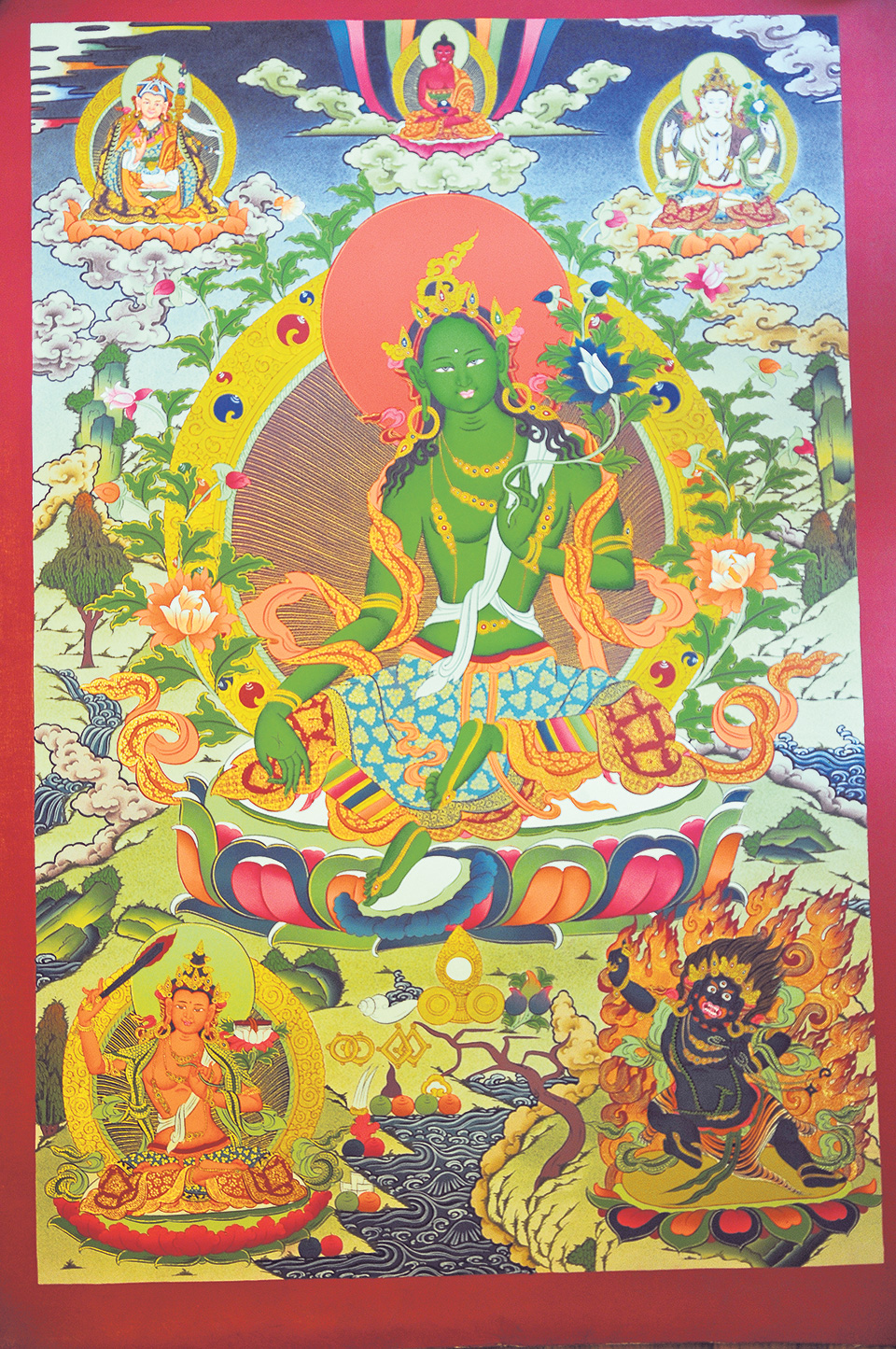
OR

Available in various colors, shapes and sizes, Thangka paintings are one of the most attractive pieces of art found in our market. Many of us even have them hanging on the walls of our homes or printed on some of the T-shirts that hang in our closet.
Yet, we do not know the relevance and significance of such piece of work.
Each artwork definitely has a specific purpose and represents certain values unique to the painting. Thangkas are extremely vast as every painting belongs to a certain category and each category is again divided into sub-categories.
The Week’s Swasti Gautam spoke to Suresh Ranjip, owner of Lucky Thangkas, Thamel, to give you an idea about this vast genre of art by picking out a few popular Thangka designs.
Understanding Thangka paintings
Thangkas are religious scroll paintings traditionally painted on silk or cotton. These handmade art pieces may depict a Buddhist God, a religious scene, or mandala which is a religious symbol in Hinduism and Buddhism depicting the universe.
These scroll paintings are highly popular in Newar and Tibetan style. “The Tibetan style paintings stick to their holy books and are extremely accurate while the Newar style gives more freedom to the artist,” says Ranjip.
For many years, Thangkas have been traditionally found in temples, monasteries and homes in South Asia. “Thangkas are not just paintings. They have their own spiritual values that need to be preserved,” says Ranjip. “But these days Thankas have become highly commercialized and are often bought by customers for merely decorating their space,” he adds.
According to Ranjip, there are many anecdotes that explain the origin of this form of art. Some claim that Thangka originated in Nepal and was exported to Tibet through Bhrikuti who married Sron Tsan Gampo, the then ruler of Tibet. This became a very popular tool among the traveling monks who used Thangkas as a means to explain the life of Buddha, Lamas and various other Gods and Goddesses.
Shakyamuni Buddha
This painting comprises of Siddhartha Gautama, the pioneer of Buddhism, who after renouncing his royal privilege went in search for the ultimate truth. Shakyamuni Buddha is a painting that depicts the moment when Gautama Buddha got his enlightenment.
His right hand pointing downward symbolizes the earth to be the witness of him getting enlightenment. Most people worship this painting to attain their peace of mind and purity of soul. The two figures below Buddha in the painting are said to be his first two disciples who were Sariputra and Mahamoggallana. Buddha seems to be seated on a lotus in most Thangka paintings where he is represented. The lotus symbolizes peace, awareness, and enlightenment.
Wheel of Life
This Tibetan style Thangka depicts the psychological state associated with the existence of a human being before enlightenment. The mandala represents the Tibetan Buddhist perspective of life or Samsara through Buddhist symbols themes and teachings.
The outer ring of the painting is divided into twelve parts that may also be studied as the various phases of life from birth to death. The inner ring is divided to represent six realms of existence that includes Gods, humans, ghosts etc. Each part shows how humans live their life and what has to be done to attain ultimate happiness.
At the centre of this Mandala is a picture of intertwined rooster, snake, and pig. This symbolically represents greed, suffering, dissatisfaction and aggression prevalent in the world. The Thangka symbolically explains how peace and happiness can be achieved only by renouncing worldly pleasure. This also shows how the path of liberation is achieved through three major forms of knowledge – knowledge of past life, knowledge of lives and deaths of other beings, and knowledge of how to get liberation from the whole process of Samsara.
Green Tara
This Thangka is said to help in removing the obstacles that come in our lives. It facilitates in removing fears and anxiety of each human and helps in leading a better life.
The green colored tara (star) symbolically represents the enlightened activities of Buddha. Therefore, she is also known as the mother of Buddhas. Green Tara is the liberator of all sorrow who was arisen out of the tears of Avalokiteswara.
She is known for her ability to lift people off their difficult situations. In most paintings, her left leg is bent and her right leg touches the lotus below her which extends beyond her throne. This shows her willingness and readiness to go and help living beings. Her thumb and ring finger is pressed together which represents wisdom and energy. The blue lotus flouting above her is the symbol of purity and power.
White Tara
White Tara represents the Goddess of compassion. The enlightened and liberated activities of Buddha are represented through this Thangka. The White Tara meditation practice is said to provide health, long life, peace, and fearlessness. This white colored Tara has seven eyes that reflect that she responds to all kinds of sufferings in the entire universe. People often worship her for long-term achievement and spiritual accomplishment.
Manjushree
Manjushree is the God of wisdom. The main purpose of Manjushree Buddha was to help in attainment of self-discovery and realizing the true nature of reality. In the painting, he is seated on a lotus throne in an extremely playful posture.
Knowledge is one of the most respected virtues in Buddhism. They believe that only wisdom can emancipate humans from the worldly pleasures. Wisdom is the only path that helps you attain great bliss and escape human suffering. Hence, Manjushree is one of the most important deities in Buddhism.
You May Like This

Know your tea
With many kinds of tea available in the market, The Week attempted to better understand tea and all its myriad... Read More...

Now, charge your phone using your body’s own energy (with video)
HandEnergy is an ingenious apple-sized device that charges your phone anytime, anywhere. But what really makes this thing special is... Read More...

Is your Google identity helping or hurting your career?
Your Google results paint a picture of who you are and reveal how visible you are on the web; and... Read More...
Just In
- KMC to organize a month-long skill fair from May 1
- Birgunj Metropolis collects over Rs 360 million in revenue
- NEPSE plunges below 2,000 points after one and a half months; daily turnover declines to Rs 2.10 billion
- AI Index Report-2024: AI still behind humans on complex tasks like competition-level mathematics
- Daiji-Jogbudha road construction at snail’s pace
- Govt fails to adopt podway technology despite its potential in Nepal
- Jhulaghat border crossing in Baitadi to remain closed from this evening
- Universities will be free from partisan interests: Education Minister


















Leave A Comment